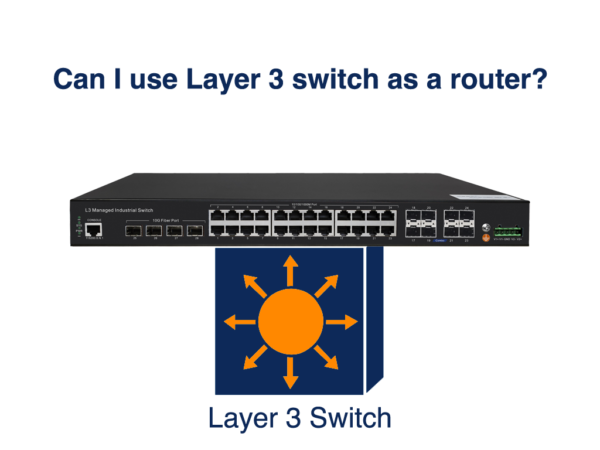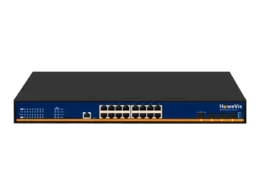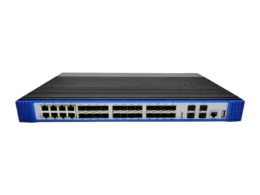Do you have a high-speed data connection? Not? Use Power over Ethernet. Within the limited range, IEEE 802.3bt can provide speeds up to 10 gigabytes per second. Usually, you need to install different systems to get your device’s power and data connection. Why not have a solution? Power over Ethernet can help you get both.
- High-speed data up to 10 gigabytes per second
- High power up to 95 watts
You might have questions regarding this system. No worries. Most buildings have built-in PoE technology. If you want to know whether your switch is compatible, look at —Does my switch support PoE?
How can I get Power over Ethernet?
You have two options to choose from.
- If you have preinstalled the PoE system, buy Ethernet switches and power your system.
- If your device is not PoE compatible, you can try it with the PoE injector.
Our main topic of discussion is the Ethernet switch, especially the type 3 Ethernet switch.
What is a Layer 3 Ethernet switch?
What is a switch? A bridge to connect different devices, right? But not here. A layer 3 switch is more than a mere switch acting as a bridge between the devices. I suppose you understand what exactly I mean. Let me define the layer 3 switch as well.
Layer 3 Ethernet switch is an Ethernet switch that connects multiple devices on the same subnet and analyzes the data packets. It works as a bridge and performs routing features to improve the data’s performance.
What is a router?
Do you have a router at your home? If yes, I suppose you know what precisely the router does for you. In actuality, the router is a device that receives data packets from one device and transfers them to the target device. In simple words, it can help you connect to the Internet. You can observe the WiFi routers that provide your devices with a data connection and transfer data packets at home.
Can I use the layer 3 switch as a router?
That’s a good question. Can you answer it? If not, no problem; I can help you decide on it. As mentioned above, the Layer 3 switch acts as a router to improve the network’s performance. You can use the Layer 3 switch for dual functions—network switch and router.
Like a router, it can perform intelligence by examining data packets and forwarding them to the target device over the IP address. Moreover, it uses traditional routing protocols like OSPF, RIP, and EIGRP to improve the network’s performance. One switch, multiple functions—quite impressive.
Layer 3 switch vs. Traditional router:
These seem to be different terms but have many similarities and differences. The switch has the function of a router, which performs only routing functions. However, here is a comprehensive list of similarities and differences between the router and layer 3 switch regarding routing features.
Similarities:
Many things are pretty essential to discuss. Most features and routing facilities are similar to the layer 3 switch and a router. However, you can look at the similarities below.
- The switch and traditional routers offer layer 3 basic routing like OSPF, EIGRP, and RIP.
- The ultimate goal is to manage the traffic over the network. Both are doing well in this aspect.
- Both receive the data packets, analyze them, and forward them to the target device.
- Both can work over the target devices’ IP and MAC addresses.
Differences:
Do they seem to be the same? Don’t make haste. There are some key differences between both devices as well. Here is how exactly they are different.
Hardware:
One of the main differences between the layer 3 switch and router is their hardware. The layer 3 switch supports the intranet devices over the LANs(local area network) while no WAN(vast area network) features exist. The layer 3 switch has some improving features to improve the network’s performance with an integrated system.
Working Principle:
It’s a bit different. However, it can be helpful to determine how both of these work differently to provide us with routing features. The Layer 3 switch receives the data packets, performs intelligence functions, and forwards them to the destination device. Compared to it, the router does an additional job by providing IP address firewall filtering.
Scope:
Regarding the scope and areas of applications, we can look at both the router and layer 3 switches. At offices, data management centers, and other places, the layer 3 switch works if there is LAN. However, it becomes challenging to do WAN features. For WAN, you can choose the traditional router to provide you with some extra features.
Size of routing table:
With the layer 3 switches, not many route entries are possible. Therefore, it has small routing tables that support only a small number of entries. Compared to it, traditional routers have an astounding number of routing entries and bigger routing tables.
Forwarding Decision:
The forwarding decision is also different on both sides. In the layer 3 switch, the forwarding feature relies on hardware ACIS, which differs from a traditional router. The conventional router offers software-enabled forwarding over the IOS. I hope you understand both of these.
Switching capacity:
As mentioned, the layer 3 switch offers routing and switching facilities. That means its ultimate design is to provide the devices with switching features. Therefore, it has a high switching capacity. You might not observe this scenario in the case of a traditional router. However, routers also provide switching features, but less than the layer 3 switches.
Port Density:
The layer 3 Ethernet switch employs a high port density, while the router uses a low one.
Which one should you choose? Router or Layer 3 switch?
Haven’t you made the decision yet? Let me make an informed decision in this case. It depends on the requirements and other features you must employ in the office or data center. For example, if you want routing and switching over the LAN network, go ahead with the layer 3 switches. You must choose a router if you need routing features with the WAN available. Therefore, it all depends on what you need and in what ways.








